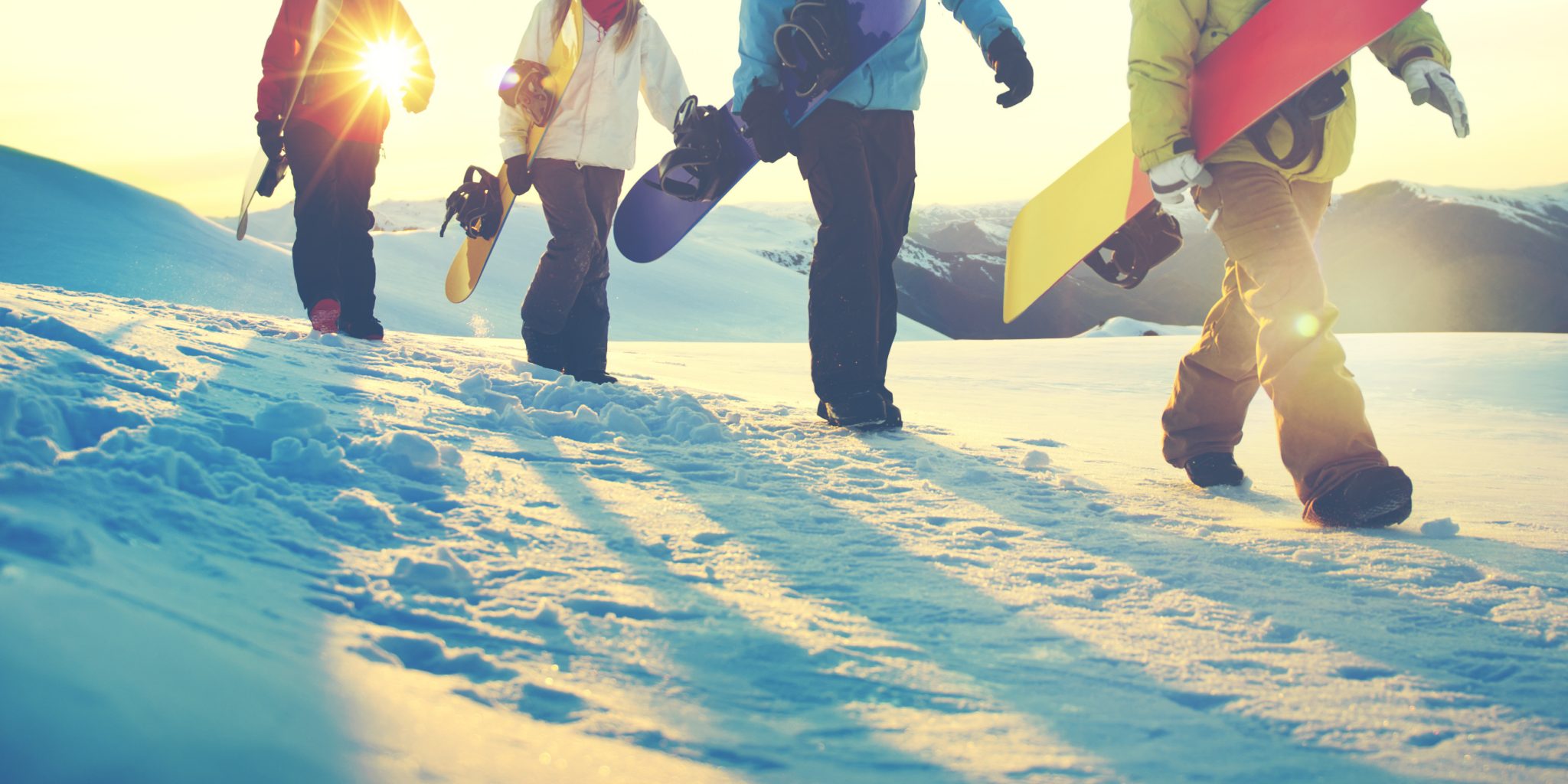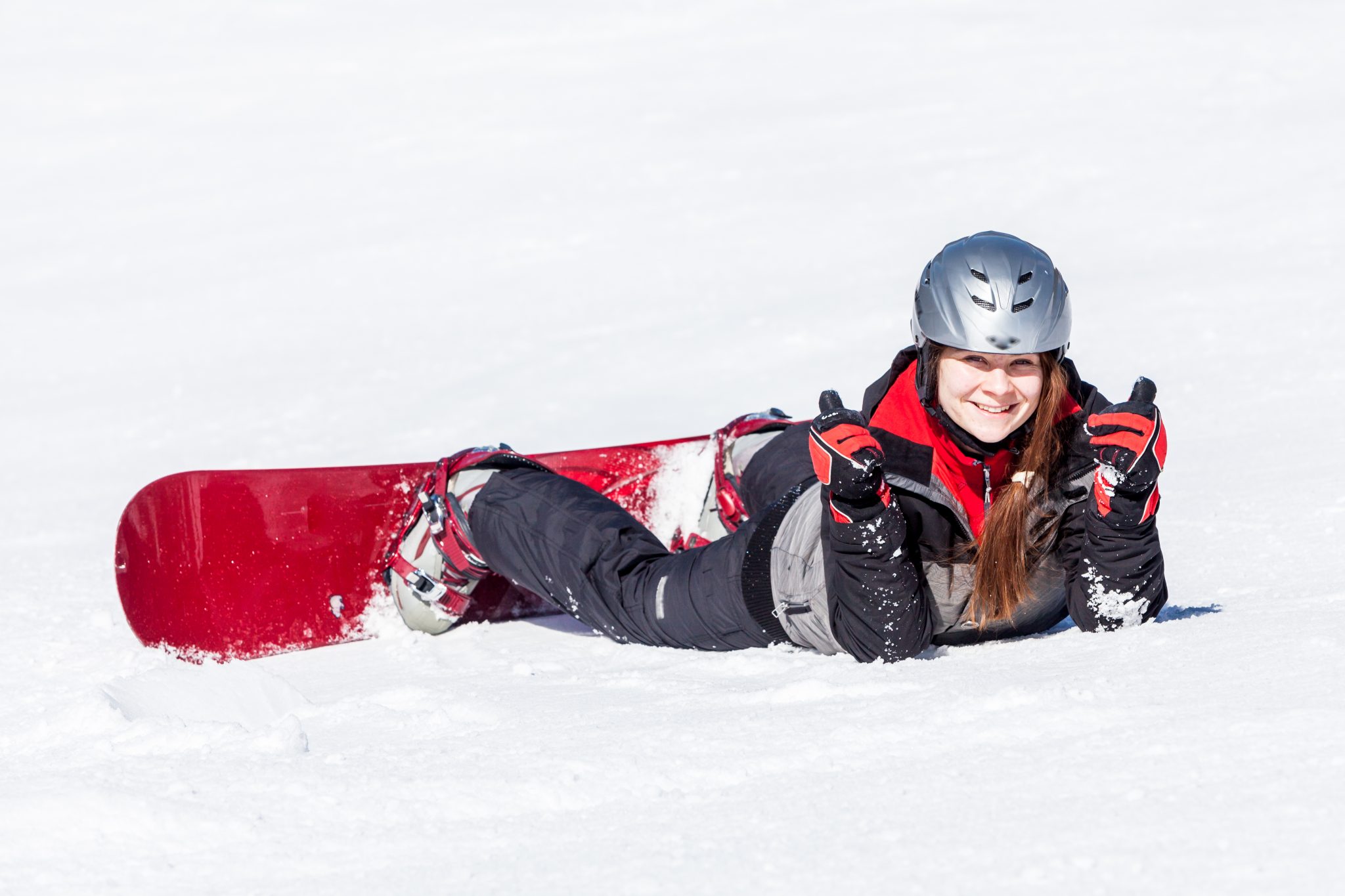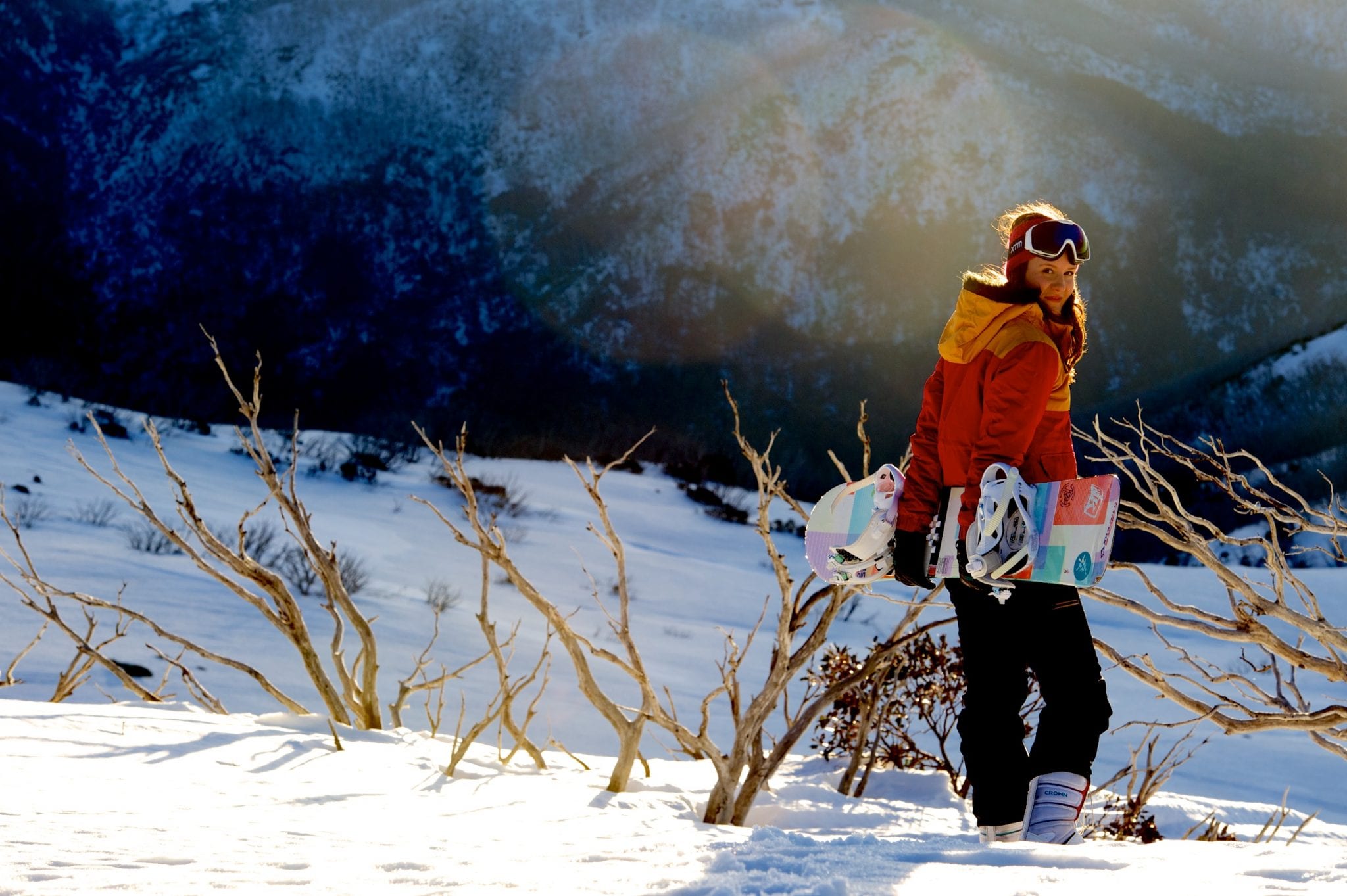The ski slopes can be a scary place for a beginner. There’s so much unfamiliar gear and terminology. What is a heel side edge? Who is this goofy character? Why are all instructors so ridiculously good looking? Alex Parsons answers all this and more.
If you’ve been wanting to get into snowboarding and found it a little daunting, or you’re at the start of your snowboarding journey and have some questions you were too afraid to ask – this is the article for you.
Before you get to the hill
What exercises can I do to help prepare my body for the pain in store?
All the squats. Just squat all day, every day. Ok but seriously the main areas you need to focus on are your legs, glutes and core. Think squats, lunges, calf raises, planks and all types of sit ups. Here’s a decent workout program. For those who hate the gym, I’m a big fan of vinyasa yoga (the more dynamic, sweat-inducing kind) for pre-season workouts as it incorporates core strength, slow and controlled movements and a lot of flexibility work.
Will snowboarding hurt?
It can. The most common beginner injuries are bruised tailbones and sprained or broken wrists. However, serious injuries in your first lesson are rare because you’re just learning the basics and will be going slow.
You can definitely expect some general soreness from using previously undiscovered muscles, and a sore butt and knees from falling. To reduce the ouchies, wear all the protective gear you like – wrist guards, helmets, knee pads, even butt pads.
I’m unfit/weak. Will snowboarding be difficult for me?
I’m not going to lie, the more unfit or weak you are, the harder it will be for you to snowboard. The main thing is that snowboarding is an extreme sport so it’s very tiring and you may struggle to stand up from a seated position with a snowboard strapped to your feet. To do this, you need to tuck your knees right up to your chest to get the leverage to push up and get going. But if you have any semblance of coordination and balance you should be ok.
What’s the hardest thing to learn in snowboarding?
In your first lesson, standing up while on a slope with both feet strapped in will be one of the hardest things you’ll have to do. The board will just keep sliding away from you unless you get the technique right, but it gets easier the more you do it. After that, just getting the right balance on your board, not leaning back, and understanding how to slow down and stop will be the next big challenges. But hey, everyone’s different. You might find that landing a triple backflip is tricky in your first lesson.
What essential gear do I need to buy (that I can’t rent)?
You usually can’t rent gloves/mittens, socks, thermal underwear, goggles and beanies. These are all essential so scope out some before you come down – ALDI is often a good option.
Should I rent or buy my board/boots/bindings/outerwear?
For first timers, definitely rent. Sure, the gear isn’t in top condition but it’s a lot cheaper than buying your own gear. I mean, you don’t even know if you like snowboarding yet. And if you buy your hardware now you won’t know what sort of board, boots and bindings are good quality and will suit you best.
At the rental shop
What do I need to rent?
The basics are a board with bindings attached and boots. You may also want to rent warm, waterproof outerwear like a jacket and pants, and safety gear like a helmet and wrist guards.
Do I really need a helmet?
Yes. A thousand times yes. Helmets are usually required for kids and I highly recommend them for adult snowboarders too.
Do I really need wrist guards?
The research shows that wrist guards really do reduce the severity of wrist injuries – which are very common in snowboarding. I think all kids should wear them, and most adults, at least while you’re learning. Can you really afford to go back to work with a broken wrist?
Do I really need goggles?
If it’s sunny and clear then good UV-blocking sunglasses can do the job. If it’s snowing you’ll want goggles to protect your eyes from snow and cover up your face so it doesn’t freeze. Goggles are also great protection from face plants.
What size board should I get?
The rental dudes should be able to help you here. Of course, different sized boards work best for different riding styles and conditions but you just want a nice beginner-friendly board.
What stance will I be?
This is an important one. Your stance refers to wether you will predominantly ride with your left foot forward (regular/natural) or right foot forward (goofy). But how do you know? Here are some ways to find out:
If you skate, surf or wakeboard, which foot do you have forwards?
If you do martial arts, what’s your preferred fighting stance?
When you slide down a wooden-floored hallway in socks (come on, we’ve all done it), which foot naturally goes forward?
Imagine you were going to kick a ball, what foot is your lead foot (the one you’re not kicking with?
Don’t freak out if you’re not 100% sure, you can always change your stance, and some people snowboard opposite to the way they surf. Other elements of stance are your binding angles and stance width. Most beginners work well with a duck stance where both feet are equally turned out but you don’t want to worry too much about angles and widths just yet. Trust in your rental peeps and if you’re concerned ask an instructor for help.
At the hill
Do I need lessons?
I cannot tell you how many people have come to me for a lesson after ‘giving it a go’ by themselves and failing epically. I once had a family lesson where they didn’t even get as far as figuring out how to put their bindings on before giving up. Snowboarding gear alone is tricky, and the techniques for stopping and changing direction don’t come intuitively.
Also, can I just say that it is such a bad idea for someone in a relationship to teach their partner. I have seen so many fights over this.
I’ve booked a lesson. What should I do before I turn up?
It can help to watch a few YouTube videos of beginner snowboarding so you understand some terminology and what’s in store for you. It’s also great if you can get familiar with your gear and know how your bindings work.
Then make sure you’re wearing and carrying everything you need, have sunblock on and don’t have a gap between your goggles and beanie/helmet – this is highly uncool among snow folk. Oh, and for the love of the snow gods, don’t put your pants on the inside of your boots.
What can I expect from my first lesson?
Keep in mind that all lessons differ due to different teaching styles, resorts, individuals and even the conditions for that day. But in general you can expect the following:
An introduction to your gear and some terminology. You’ll learn how to move around on the flat with one foot out, via skating. Stepping up a small hill and gliding straight down, then possibly with a direction change. Perhaps a chairlift introduction (this really depends on the resort set up). How to strap your other foot in and stand up. How to start moving down a hill, slow down and stop on your heel side edge.
If you go a little further, you might cover how to change direction on your heel side edge. If your group picks things up really fast, or you’re in a private lesson, you may progress to learning how to slow down and stop on your toe side edge.

I have x many friends, can we stay together in a lesson?
If you’re all the same level and book a private lesson together, then sure. If you’ve booked a group lesson then it may be harder to accommodate if you have a big group, but we usually have no problem keeping between 2 and 4 friends in a group of the same level.
However, if you’re all different levels it will be very difficult to accommodate you because you’ll all need to be taught different skills. And will the most advanced person really want to be patient and re-learn what they already know? Either way, a private lesson is your best bet.
What happens if I have a lesson and pick it up faster/slower than others?
There is always going to be a split in first timer lessons. Instructors are used to this and will cater the class to the slowest learner, although they may feel pushed and get some extra attention. Those who learn quickly may need to be patient in their first lesson, and hopefully the instructor can give you more advanced techniques if they have time.
Regardless if you pick up snowboarding faster or slower than the norm, a private lesson can be great so you get a tailored experience that’s exactly right for your skill level.
What’s a good way to fall?
Essentially, avoid falling on your wrists at all costs. If you’re falling backwards then tuck your arms in and take the brunt of the force on your nicely padded butt, rolling a bit up your back to disperse energy. If you’re falling forwards, make fists and try to land on your knees and forearms to dissipate the force.

What do I do after my lesson?
Say thank you to your instructor and if you really love us, tip us! I know lessons are expensive, but instructors usually see less than 10% of that price in their pay cheque. Next, take a rest, drink lots of water and have some food.
If you’re keen to get out there again, try to copy what your instructor taught you on the same hill. The worst thing you can do is go exploring, end up on a Blue (intermediate) or Black (advanced) run and scare yourself.
Gear troubles
Why do I have really wet gloves?
Because starting out in snowboarding means a lot of hand-to-snow contact when you’re getting up. Plus, your gloves probably aren’t the most waterproof things in the world. If you’re going to invest in anything, invest in gloves with quality leather palms that you put waterproofing wax on. Bringing backup gloves can also really save your day.
Why is my butt so cold and sore?
That would be because you’re sitting on it a lot, and falling on it too. Even the most waterproof of pants will eventually get wet if you’re sitting on partially solidified water. Butt pads, wearing thermals and insulated, waterproof pants will help all of the above, but mostly getting better at snowboarding will save your rear end.
Why are my feet numb and freezing?
Many reasons! You may have gotten hot and sweaty in your boots and then had the sweat cool. Your boots might have leaked water through. They may be too tight so they’re cutting off circulation. You may have the wrong type of socks (wool and synthetic materials are the best).
Good boot fit is one of the most important parts of snowboarding – you want them to be tight but not uncomfortable, and cushy inner soles can keep you snowboarding in comfort for longer. Also, don’t wear two pairs of socks. You’re better off with one decent pair as it leaves more room for a warm air pocket to form. Your toes will thank you.
The clothes under my outerwear are wet and making me freeze. What’s up with that?
The most likely explanation is that you’re sweating while riding and then that moisture is cooling and making you cold. This means you’re either wearing too many layers for the weather or your underwear is made out of the wrong fabric. Cotton is your enemy when snowboarding because it holds water and will make you cold. You need synthetic fabrics like nylon or wool that wick sweat away from the body.
Getting better on the hill
What happens if I hurt myself during the lesson, or out on the mountain?
If you’re in a lesson, relax, your instructor will help you out and get ski patrol over if necessary. Ski patrol will then check you out and take you to the resort’s medical centre, who will take it from there.
If you’re on your own, it’s really handy to have ski patrol’s number in your phone. Give them as much detail as you can about where you are and what the problem is. If you don’t have their number then try to get hold of a nearby instructor or lift operator – they practically have ski patrol on speed dial.
Standing up is really hard, how can I make it easier?
Nearly everyone struggles with this as it requires a certain amount of flexibility, strength and body awareness.
Here are some tips and tricks:
Have your board perfectly horizontal across the hill.
Tuck your knees in close.
Keep the front edge of your board up by flexing your toes and ankles up.
Dig the heel side edge of your board into the snow to create a platform.
Keep your back hand as close to your butt as possible for leverage. The other hand can grab the front of your board between your legs.
Stand up with the weight in your heels, pushing the heel side edge into the snow.
Lean forward, give a good push off your hands and try to get up quick.
It may be hard and you may struggle a lot but eventually you will get it. Everyone does. If you become disheartened, you can roll onto your belly and learn how to use your toe side edge first.
I’m not sure if I have the correct foot forward, should I change?
You can change, it’s not a problem (unless you have a directional board where the nose and tail are different – this shouldn’t be the case if you’ve rented). But keep in mind that most beginners feel like this because everything is new and weird feeling.
How do I stop?
Ah yes, I’ve heard this one screamed a lot. The easiest way for beginners is to get that board sideways and dig your heel side edge into the snow. Lift the front of your feet up, flex your ankles up with your weight pushing down through your heels, bend your knees and get your butt down low like you’re doing an epic squat.
This will put a lot of the weight over the heel side edge of the board to create more friction in the snow and slow you down. Remember, if your board is angled in any direction but horizontal to the hill, it will start to slip that way. And if all else fails, sit down on your butt.
How do I not fall over at the top of the chairlift?
I’m going to tell you a secret – chairlifts are not particularly designed for snowboarders. They’re absolutely great for skiers because you just keep your skis straight and glide away like a figure skater, but they are the bane of a beginner snowboarder’s existence.
Getting off a chairlift without falling is something that requires a lot of practice. When you’re getting near the top of the chairlift, shuffle sideways onto one butt cheek so the nose of your board is facing forwards.
Keep your board as STRAIGHT and FLAT as possible when your board makes contact with the chairlift run-off. Keep looking dead ahead, NOT at your board or anyone beside you. Another common problem is leaning back and not wanting to relinquish the chairlift. Instead, let that safety blanket go and keep your weight centred over your board like a good snowboarder.
I feel like I go way too fast and then fall over. What am I doing wrong?
Speed is something that will become more familiar the more you ride, but if you’re bailing every time it means you don’t feel comfortable at that speed and need to work on your control. Remember that when your board is going straight, that’s the accelerator. When your board is horizontal across the hill, that’s the brake.
So the longer you have your board going straight, the more speed you’ll pick up. As a beginner, you want to keep that board mostly horizontal, only angling down the hill and going straight on occasion before putting on the brakes again.
Is skiing easier?
Many people find that skiing is easier to start. And I do recommend it for some people because you will fall less in the early stages. It’s a good option for people who may be injured (especially back, hips, shoulders or wrists), frail, older, lacking in strength, have poor balance, or are very overweight.
That’s not to say these people can’t snowboard – anyone can snowboard given enough time and guidance – but your average weekender doesn’t want to struggle heaps and spend a lot of painful hours and money on lessons to get the hang of snowboarding when they may pick up skiing more easily.
Of course, some people take to snowboarding better. And after the initial stage you typically progress in snowboarding a lot faster than skiing. On average, it takes 3-4 lessons (supplemented with your own solo practice) until you’re ripping up the hill.
I think if you have decent balance, have done any board sports (skateboarding, wake-boarding, surfing), can take a bit of a beating and are generally a badass – you’re destined to be a snowboarder.
This is an edited version of a blog post on Big World Little Cat by Alex Parsons. Follow Alex on Instagram and Alex on Twitter.






